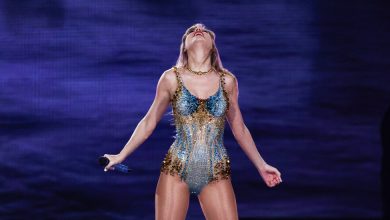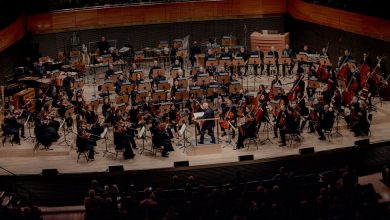Brigitte Lefèvre, Ballet’s Disciplined Rebel, Takes Her Next Steps

CANNES, France — The Carolyn Carlson Company had just finished the final performance of the two-week long Cannes Dance Festival on Dec. 11, and the festival director, Brigitte Lefèvre, went onstage to begin a post-show conversation. But Carlson is not much of a talker. Instead of discussing her piece, she began a little mime routine, to which Lefèvre responded with Chaplinesque comedic timing, mimicking bashful reluctance and deference to Carlson as the audience roared its approval.
It was a fitting conclusion to Lefèvre’s final turn as the director of the Cannes festival, a low-key but vibrant biennial that offers both well known and experimental work. She took on the role in 2015, soon after retiring as director of the Paris Opera Ballet.
Lefèvre, 77, looks pretty much as she did in 1992, when she arrived at the Opera: a redhead with a gamine cut and an unaffected style. (I was there too, toiling in an attic as an editorial assistant.) In 1994 she replaced Patrick Dupond, probably France’s most famous dance personality, as the company’s director, a position she held for 19 years. It was an appointment that met with a mixed response, even though Lefèvre had attended the Paris Opera Ballet School and danced with the company for 11 years.
“I don’t think it was because I was a woman,” she said an interview over lunch on the festival’s final day. “I was 50, I wasn’t famous, and I had left the world of classical dance for a while. But I didn’t think I had to justify myself about that.”
Lefèvre, along with her close friend Jacques Garnier, had left the Opera in 1972 to form Le Théâtre du Silence, which — unconventionally at the time — programmed contemporary dance works by Merce Cunningham and David Gordon. alongside ballet choreographers like Roland Petit and Maurice Béjart.
“There was a kind of war between classical and contemporary dance at that point,” said Didier Deschamps, the former director of Chaillot National Dance Theater in Paris, who will succeed Lefèvre as the director of the Cannes Dance Festival. “They showed very concretely that you could have common terrain.”
Lefèvre took exactly that idea to the Paris Opera Ballet, inviting more than 40 choreographers, both classical and contemporary, to create or stage works during her tenure: Jérôme Bel, Trisha Brown, Sidi Larbi Cherkaoui, Jiri Kylian, William Forsythe and Angelin Préljocaj, to name just a few. Many were well known to her from her years heading France’s first Delegation de la Danse, a group appointed by the Ministry of Culture to improve conditions for dance; by establishing choreographic centers, with resident companies all over the country, it changed the dance landscape.
“Brigitte had political instincts and a capacity for organization, but it was her knowledge of the dance world that was most important and gave her such authority,” Deschamps said. “And she always knew how to make herself heard.”
That hasn’t changed. In a long conversation, filled with humorous asides, occasional aperçus (“In life and art you need to be a rebel and also disciplined — in whichever order”), and a diplomat’s knack for discretion, Lefèvre spoke, in French, about her early years, her time at the Paris Opera Ballet, and her thoughts about trends in the dance world. Here are edited excerpts from the conversation.
Why did you decide to retire from the Cannes Festival?
During lockdown I spent a lot of time in Brittany, and I learned something unexpected; that being in nature really satisfied something in my spirit. Also, I felt I was perhaps continuing rather than innovating in Cannes. It was time.
You have always been interested in innovation and change. How did you fit in at the Opera with its strict system of promotion?
Of course, I wanted to advance, get better roles, be better paid. But I wouldn’t say I was desperate about it. I was very individual in my tastes, partly because my mother, who was a pianist, introduced me first to rhythmic dance, which was a bit Isadora Duncan, later to flamenco, and I always had an appetite for dance outside ballet. I was also aware I hadn’t done secondary studies, so I read a lot of literature and philosophy.
I adored being onstage, being backstage, the stage machinery, watching the great dancers. I learned about Martha Graham and other contemporary choreographers and I started to take some exterior classes in other techniques. The Opera wasn’t my entire world.
Norbert Schmucki, who danced with you then, said he thought there was a moment when you needed to leave the confines of the company.
Jacques Garnier and I shared a spirit of eclecticism; we wanted to be open to the world and create dance there, not just at the Paris Opera. We laughed so much coming up with “Le Théâtre du Silence.” A friend said, “With a name like that, I know I’ll be bored the whole night!”
Jacques and I both choreographed for the troupe. I always felt I wasn’t daring enough, I didn’t have enough confidence as a creator. But we also invited Douglas Gordon, Robert Kovich, Lar Lubovitch and Merce Cunningham, who staged “Summerspace” and “Changing Steps” for us, and who really changed my life artistically. People don’t talk about the Théâtre du Silence now, but I think we showed a lot that people hadn’t been exposed to before.
You worked for the Ministry of Culture after closing the Théâtre du Silence in 1985, then went to the Opera as a general administrator in 1992. What was it like to be back?
It was all a bit difficult. It was the start of having both the Palais Garnier and the Opera Bastille, and there was a complicated hierarchy. Patrick Dupond, who I knew well and admired, was a great artist, but that doesn’t mean he was good at running a company. When Hughes Galles arrived as general director in 1994, he asked me to take over the ballet company. I didn’t want a conflict with Patrick, but I was interested, I felt ready, and I felt the situation couldn’t go on as it was.
It wasn’t a very happy time for me. I felt I was perceived as the villain.
During your tenure at the Opera, you were criticized for commissioning so many contemporary dance-makers. What was your vision for the company’s repertory?
I didn’t really have a vision. I wanted the dancers to have great experiences. I didn’t think about quotas of classical or modern, just what would be interesting to dance. I also wanted the audience to learn about dance through the programs. If you put Trisha Brown, William Forsythe and Balanchine together on a mixed bill, there are resonances and links.
We did plenty of classical dance, a lot of Jerome Robbins and Balanchine, who I had met when he staged “The Four Temperaments” at the Opera in the 1960s. I was completely in love with him, and I wasn’t the only one! I also saw that Rudolf Nureyev, a fiery personality who was so criticized when he was running the company, was becoming a myth. After he died, I thought we must keep his works. I am a bit sentimental about that.
I asked many company dancers to create ballets; also Benjamin Millepied and Alexei Ratmansky. I loved having living choreographers in the house.
It was no secret that when you left the Opera, you wanted the former étoile Laurent Hilaire to succeed you rather than Benjamin Millepied, who was followed by Aurélie Dupont in 2016. What are your thoughts now?
It’s very hard to succeed someone who has been there for more than 20 years and under whom, if I may say it, things went relatively well. I think Stéphane Lissner [then the director of the Paris Opera] wanted change and a new energy, but ultimately it was hard for Benjamin. I admire his choreography and think he could be a good, even a great, director. If that’s what he wants; it’s a job you have to be totally devoted to.
I think a lot has changed, and the stakes are different. I am always in solidarity with the Opera, the dancers, the directors, above all after this awful period.
What do you think about the new emphasis in the ballet world on female choreographers as well as the need for more racial diversity and sensitivity?
Marie-Agnès Gillot was the only Opera woman I asked to make a work, and perhaps I should have encouraged others. I think women are often self-critical, we doubt ourselves; I certainly did. If I ran a company now, I would be more attentive to the issue. I think the militancy I had around contemporary dance would express itself in that area today.
As for #MeToo or diversity, how can you be against that? It’s always important to take into account, and be attentive to, peoples’ sufferings. But you need to be on guard against a proselytizing position that can be counterproductive.
What did you bring from Paris Opera Ballet into your festival programming?
My choreographic knowledge, and the idea, which I have always held to, of showing the diversity of dance. I wanted to bring people together rather than being conceptual. I think many of the French regional ballet companies are really opening up the repertory, and alongside there are young choreographers coming out of the choreographic centers. I love the thought of people experiencing different artists, different aesthetics, creating their own history with dance.
What do you want to do next?
I want to dance and vibrate as an artist! I’m waiting for some offers. Everyone laughs when I say that. It’s a bit annoying.




